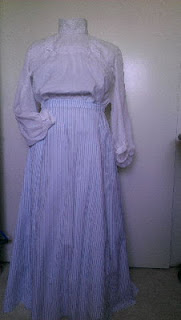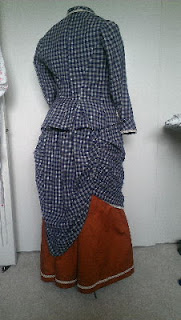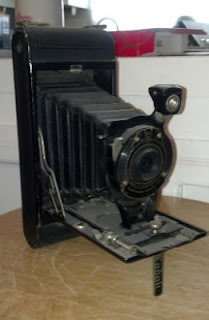May 10,2013
A couple
months ago after once again lugging my very heavy Husqvarna sewing machine to
another sewing workshop, I convinced myself that it was time to get one of the
very light Singer Featherweight sewing machines. Many years ago when I was
still in my quilting stage, and also going to sewing workshops, I’d admired
those cute little black shiny machines that some of the other ladies brought.
They only weigh 11 lbs, and the hinged extension table folded up for ease of
storage. But the $100 price tag was out
of my wallet’s reach at the time
The first
one that really caught my eye was a red one on ebay. He was asking $600 for it.
Not surprisingly it didn’t sell. Later I found out the machines were never
produced in red. They only came in black, beige, and white. Any other color was
a re-paint. But that didn’t keep me from drooling over the red one. Pink would
be nice too. Oooh, a friend just shared a photo of a pink one she found.


With the
help of some friends, a couple promising ones popped up in stores and on ebay.
But I was out of state at the time and I wanted to take my time. So now with a
few more dollars in my wallet, and having it increased with some birthday
present money from my Mom, I went on the hunt. I even searched while I was with my Mom, and
was shocked by the $400 prices I was seeing. Since I knew they could still be
found for under $300, I kept looking. In
the meantime I started looking for information and history on these little
beauties. One of the best sources for
information was on this Singer featherweight website. Singer Featherweight They’re
also known as SIMANCO (Singer Manufacturing Company)
I’m not
really sure why some Featherweights are more desirable than others, as shown by
how people are bidding on them on ebay. Obvious ones are in excellent
condition, or from an original owner. And people seem to really want to know
the serial number so they can tell what year it was made in that you can look
up on the Singer website. Singer serial numbers
You may also remember my earlier
machine, the little baby Singer, also called the SewHandy, and I’m finding more
information about those too.
The Featherweight
machines were manufactured in the US between 1933 to the mid-1960s. They also
began producing them in Great Britain in 1947 at their Singer Kilbowie
(Clydebank) plant in Scotland. They were extremely popular, selling 1.75
million. So this is why there’s so many out there. They’re great little work
horses and not much can go wrong with them. The only parts that seem to wear
out are the belt, needles, and light bulb. The easiest way to test them if they
work is just sew something!
A few weeks
ago my next door neighbor, MaryLou, called me and asked if I’d found my sewing
machine. I told her I didn’t, and she said she was giving me hers and would be
bringing it over shortly. !!!! What. What?!! Whoo Hoo!!
This is the
little beauty she brought over. The 221K white-green one! This is the primo one
everyone wants. She’s the second owner and knowing her, it’s been well taken
care of, right down to a little bag she made to hold the presser foot so it
didn’t scratch the machine while it was in its case. The case was in great
condition and is the original one but it was painted white. When she bought it
the leather was peeling off. So her husband removed the leather and painted it
white to match the machine. But it still has its green handle. It has a copy of
the instruction manual, a book on Singer 221 Featherweights by Nancy Johnson-Srebro, some kind of presser
foot, machine oil, bobbins and needles. I’m still looking around to see what
kind of attachments it can use but I think the accessory presser foot is for
gathering or pleating.
This is what the case originally looked like. All the others were black.
I’m not sure
where the serial number is. I’ve found a few numbers on it, but the bottom is
covered and I don’t want to remove it just yet. Anyone that has any suggestions
or answers, I’d welcome that.



A friend of
mine, MaryJane, wrote to me about my machine: “I worked for Singer for several years and
always wanted to own a Featherweight. They just keep on sewing
and sewing and are so reliable. The green ones are especially sought
after and the color is officially called Pale Turquoise. Your
neighbor must know that you will treasure this little beauty to give you such a
valuable gift. They are currently selling for up to $900 if in excellent
condition. This color of the Featherweight was made in Clydebank, Scotland and the belts on them are
almost indestructible and the one you have probably has the original
belt. If you are interested in learning more about your new
addition, Nancy Johnson-Srebro wrote a whole book about the Machine
entitled Featherweight 221:
The Perfect Portable. Singer also made a free arm version of the
Featherweight, but these are extremely rare since they were made in England and
not exported to the US at the time they were manufactured.”
*************************************************************
If you’re
interested in these machines, I found these bit of facts on each of these
websites.
Originally launched in 1933 the Singer
Featherweight model 221 was only made in the USA, until it finally stopped
production there in 1957 after more than 1.75 million had been made. The similar
Featherweight 221K was produced at the Singer plant in Kilbowie, Scotland from
1947 until the late 1960's after more than 350,000 had been produced.
By the early 1960's with sales of the classic
black model dropping, the factory started to produce a new white model, the
Featherweight 221K-7.
The white K7 variants ranged in colour from creamy white to
ivory to ‘celery‘ or pale green-white. (Me-
Also referred to as light turquoise).
221J tan models range from creamy beige to light brown. These are the
only original colours produced, however in the US it is popular to respray them
completely different colours with car paint!
Produced in
Great Britain btn 1955-1964 in limited numbers by Singer in Kilbowie,
Scotland.
It was
slightly lighter than the Black 221, having a shorter extension table, an
internal toothed rubber belt linking the top and bottom gears and the later
models had a full width foot controller.
Serial
number on these machines is located underneath the machine.
The original drive belts on these
machines were also white. It is acceptable to replace a drive with a new belt
but the white belt should be saved in case you want to either display or sell
the machine. The machine has a gold-colored paper with a red "S"
medallion.
Pale turquoise
Featherweights are quite different from the black and red ones seen above.
White Featherweights are not nearly as fancy and the folding extension is much
shorter. The machine is slightly lighter and quieter than a black model. These
white machines are made in Great Britain. The serial number of this one is
EV924169 indicating it was manufactured in 1964. We found it in Clarence, New
York.
A number of attachments are
available for Featherweights including buttonholers, zig-zaggers and walking
feet.
*This blog
entry is dedicated to my friend, MaryLou, who gave me this beautiful work of
art*




















.jpg)

.jpg)





































